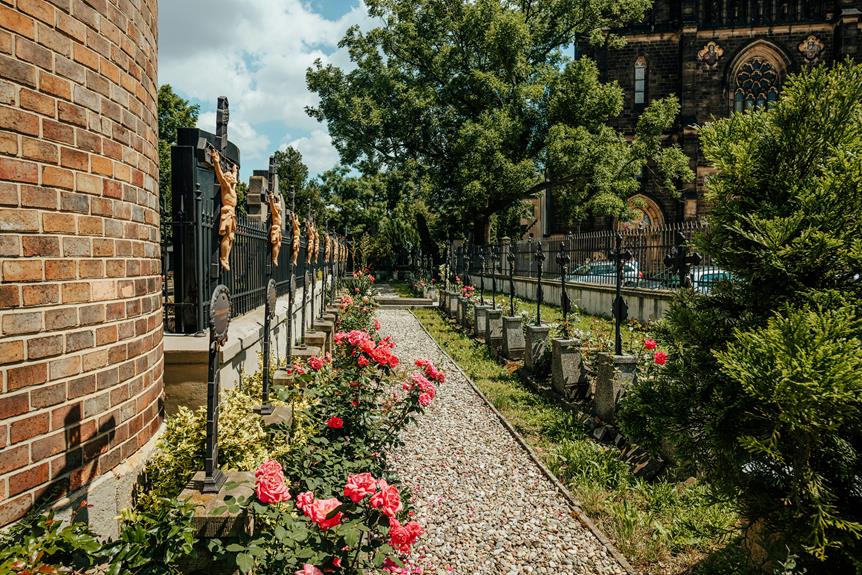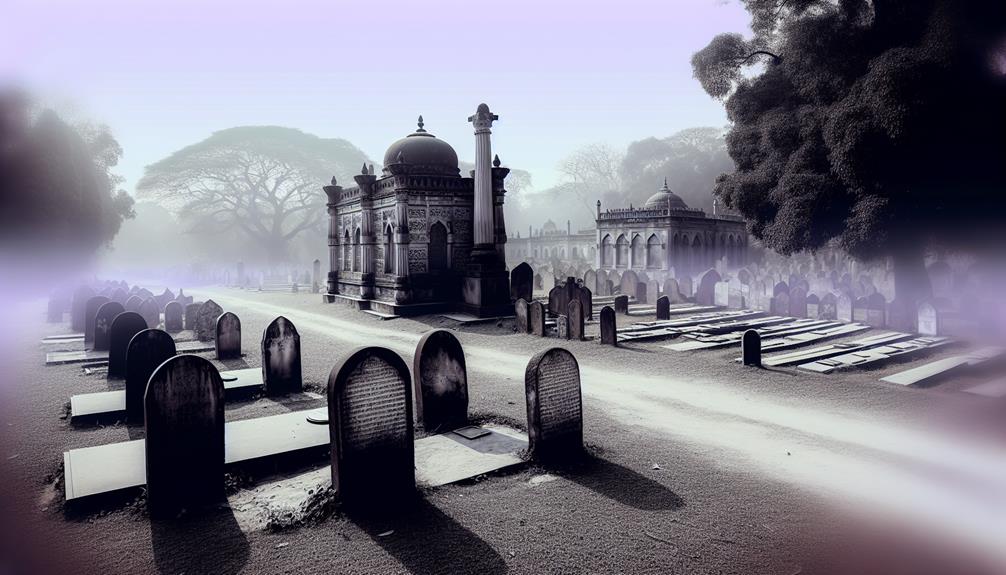Nestled within the heart of Prague, the Jewish Cemetery stands as a silent witness to centuries of history, tradition, and resilience. Walking through its weathered gates, visitors are greeted by a maze of tombstones that whisper tales of bygone eras and illustrious figures. The cemetery's somber beauty and intricate design invite contemplation on the lives and legacies of those laid to rest within its hallowed grounds. With each step, the visitor is transported through time, immersed in a world where past and present converge, leaving them with a profound sense of curiosity and a desire to uncover the untold stories that lie beneath the surface.
Key Takeaways
- Historical significance dating back to the 15th century
- Blend of Gothic, Renaissance, Baroque, and Art Nouveau styles
- Notable burials include Rabbi Loew and David Gans
- Preservation efforts rely on community involvement and fundraising
- Visitor etiquette emphasizes respect, solemnity, and mindfulness
Historical Background
With roots dating back centuries, the historical background of Prague's Jewish Cemetery is a complex tapestry interwoven with cultural and religious significance. This sacred burial ground is a poignant reflection of Jewish history and burial customs, offering a window into the traditions and practices of the Jewish community in Prague and beyond.
Jewish history in Prague is rich and storied, with a community that has faced periods of prosperity as well as persecution. The Jewish Cemetery stands as a testament to the resilience and enduring presence of the Jewish people in the city. Through the centuries, the cemetery has served as a final resting place for generations of Jewish families, preserving their memory and honoring their legacy.
Burial customs play a significant role in Jewish tradition, emphasizing respect for the deceased and the importance of maintaining connections to the past. The layout of the graves, the orientation of the tombstones, and the overall design of the cemetery all reflect these customs and beliefs. Each gravestone tells a story, not just of the individual buried there, but of the community as a whole.
In exploring the historical background of Prague's Jewish Cemetery, one gains a deeper appreciation for the interconnectedness of Jewish history, burial customs, and cultural preservation. The cemetery stands as a solemn reminder of the enduring legacy of the Jewish people and the importance of honoring those who came before us.
Architectural Features
The architectural features of Prague's Jewish Cemetery intricately reflect centuries of cultural and religious heritage, embodying a profound sense of reverence and historical significance. The cemetery's structural design showcases a unique blend of styles influenced by various periods, from the Gothic and Renaissance to the Baroque and Art Nouveau. Each tombstone is meticulously crafted, adorned with ornate engravings that tell stories of lives lived and lost.
| Structural Design | Ornate Engravings |
|---|---|
| Intricate patterns and motifs | Detailed depictions of religious symbols |
| Varying heights and shapes | Inscriptions in Hebrew and Czech |
| Weathered by time, yet standing strong | Symbolic representations of the deceased |
| Symbolic entry gates and archways | Floral and geometric designs |
The tombstones in Prague's Jewish Cemetery are not merely markers of the deceased but rather works of art that pay homage to the rich cultural tapestry of the Jewish community. The structural elements of the cemetery, such as the arrangement of the tombstones in tight clusters and the winding pathways, create a sense of intimacy and reverence for the departed.
Symbolism of Tombstones
Reflecting a deep reverence for the departed and the enduring cultural legacy of Prague's Jewish community, the tombstones in the cemetery are imbued with profound symbolism that transcends mere markers of remembrance. Rooted in rich religious traditions and memorial art, each tombstone tells a story through its epitaph meanings and carved symbols.
The tombstones in Prague's Jewish Cemetery serve as poignant reminders of the individuals laid to rest. Carved symbols such as hands, stars, and candles often adorn the tombstones, each carrying specific meanings deeply rooted in Jewish customs. These symbols not only pay tribute to the deceased but also serve as a way to communicate their virtues and values to future generations.
Epitaphs on the tombstones further enrich the symbolism present in the cemetery. These inscriptions offer glimpses into the lives of those memorialized, sharing their achievements, beliefs, and relationships. Through these epitaphs, visitors can gain a deeper understanding of the diverse and vibrant Jewish community that once thrived in Prague.
The intricate details and symbolism found on the tombstones of Prague's Jewish Cemetery highlight the craftsmanship and thoughtfulness that went into honoring the departed. Each tombstone stands as a unique piece of art, encapsulating the enduring legacy of those who rest in this sacred ground.
Notable Burials
Amidst the solemn beauty of Prague's Jewish Cemetery lie the resting places of notable individuals whose contributions have left an indelible mark on history. The cemetery serves as the final resting place for many famous figures, each with a unique story to tell. One such notable burial is that of Rabbi Judah Loew ben Bezalel, also known as the Maharal of Prague. Rabbi Loew was a prominent Talmudic scholar and philosopher, remembered for his wisdom and teachings that continue to inspire generations.
Another significant figure interred in the cemetery is David Gans, a renowned astronomer, mathematician, and historian. Gans made substantial contributions to the fields of astronomy and mathematics during the Renaissance period. His grave serves as a reminder of his intellectual prowess and lasting impact on scientific thought.
In addition to these famous figures, the Jewish Cemetery in Prague is adorned with memorial art that reflects the rich cultural heritage of the Jewish community. Intricately carved tombstones and monuments stand as tributes to the artistic skill and reverence for the deceased. These memorial artworks not only honor the individuals buried within the cemetery but also serve as a poignant reminder of the enduring legacy of those who came before us.
Preservation Efforts
Preservation efforts for Prague's Jewish Cemetery encompass a comprehensive strategy aimed at safeguarding its historical significance and architectural integrity for future generations. To achieve this goal, the following initiatives have been implemented:
- Community Involvement: The preservation efforts rely heavily on active participation from the local community. Volunteers, historians, and preservation experts work together to guarantee that the cemetery is maintained and protected. Community engagement not only fosters a sense of ownership but also spreads awareness about the importance of preserving this cultural heritage site.
- Fundraising Campaigns: To support the maintenance and restoration of the cemetery, fundraising campaigns are regularly organized. These campaigns aim to gather financial resources to carry out essential preservation work, such as repairing damaged tombstones, maintaining the surrounding landscape, and implementing conservation measures. Donors from around the world contribute to these campaigns, underscoring the global significance of the cemetery.
- Educational Programs: Preservation efforts include educational programs designed to educate visitors and the local community about the history and significance of the cemetery. By providing insights into the cultural and historical context of the site, these programs foster a deeper appreciation for the cemetery and its role in preserving Jewish heritage in Prague.
Visitor Information
Ensuring a meaningful and informative experience for visitors, the provision of detailed visitor information is a pivotal aspect of enhancing engagement with Prague's Jewish Cemetery. When visiting this sacred site, it is essential to adhere to visitor etiquette to show respect for the deceased and their families. Visitors are encouraged to maintain a solemn and quiet demeanor throughout their time in the cemetery. This includes refraining from any loud noises, such as talking loudly or playing music, that could disturb the peaceful atmosphere of the cemetery.
In terms of photography guidelines, visitors are asked to approach this activity with sensitivity and mindfulness. Photography can be a way to preserve memories and share the beauty of the cemetery with others; however, it is of utmost importance to do so respectfully. When taking photos, be mindful of the surroundings and avoid disrupting other visitors. Additionally, it is important to remember that the cemetery is a place of mourning and reflection for many, so make sure that your photography is done discreetly and with the utmost respect for the sanctity of the space.
Cultural Significance
The historical and spiritual significance of Prague's Jewish Cemetery is deeply embedded in the rich tapestry of Jewish heritage and cultural history, contributing to its profound cultural importance. The cemetery holds immense significance for the Jewish community and beyond, serving as a poignant reminder of the trials and triumphs experienced by generations past.
- Significance in Jewish Heritage: The Jewish Cemetery in Prague stands as one of the oldest and most important Jewish burial grounds in Europe, dating back to the 15th century. It represents a place of reverence and remembrance for the Jewish community, preserving the memory of those who came before and honoring their legacy.
- Symbolism and Rituals: The cemetery is a sacred space where Jewish burial rituals and customs are observed with great respect and adherence to tradition. Each gravestone tells a story, reflecting the individual's life and family history, while also symbolizing the continuity of Jewish life and faith through the ages.
- Cultural Preservation: Beyond its religious significance, the cemetery serves as a cultural and historical landmark, offering valuable insights into the social, artistic, and intellectual contributions of Prague's Jewish community. It stands as a tribute to resilience, perseverance, and the enduring spirit of a people who have faced adversity with unwavering determination.
Frequently Asked Questions
Are There Any Legends or Ghost Stories Associated With the Cemetery?
Haunting tales and folklore often intertwine with legends of paranormal activity and myths. These narratives can provide insight into cultural beliefs and historical events.
Across various locations, stories of ghosts and otherworldly encounters capture the imagination of many. Exploring these accounts can offer a glimpse into the human fascination with the supernatural and the ways in which these tales shape our understanding of the world around us.
How Does the Local Community View the Cemetery's Significance?
Local perspectives on the significance of the cemetery are deeply intertwined with its cultural heritage. The community values the site as a symbol of historical continuity, honoring the memories of past generations.
The cemetery serves as a poignant reminder of the rich tapestry of Jewish life and traditions, fostering a sense of connection to their roots and a collective identity. Its preservation is paramount to safeguarding a tangible link to the past for future generations.
Is There Any Ongoing Research or Archaeological Work at the Site?
Ongoing research and archaeological work at the site have sparked curiosity and scholarly interest. The investigations explore the historical, cultural, and societal aspects surrounding the place, shedding light on its significance and value to the community.
Through these endeavors, a deeper understanding of the site's heritage and its intrinsic importance is being uncovered, enriching the collective knowledge and appreciation of this cultural gem.
What Is the Process for Obtaining Permission to Visit the Cemetery?
To visit the cemetery, it is imperative to understand the permission process, especially considering its cultural significance. Visitors typically need to contact the appropriate authorities or organizations overseeing the site to request access. This process may involve submitting a formal application, providing relevant personal information, and possibly adhering to specific guidelines or restrictions set forth by the custodians of the cemetery.
Understanding and respecting these procedures is essential for a meaningful and respectful visit.
Are There Any Unique Traditions or Rituals Practiced at the Cemetery?
Unique customs and burial practices at this historic cemetery reflect a rich cultural tapestry. Visitors often witness solemn rituals like placing stones on gravestones to honor the deceased, a practice symbolizing remembrance and respect.
Additionally, the tradition of burying multiple individuals on top of one another due to limited space creates a visually striking and thought-provoking sight, showcasing the cemetery's rich history and unique approach to honoring the departed.
Conclusion
To sum up, the Jewish Cemetery in Prague stands as a timeless mosaic of history, tradition, and remembrance, like a tapestry woven with threads of resilience and cultural heritage.
Each tombstone, each burial, and each preservation effort serve as a testament to the enduring spirit of the Jewish community.
Visitors are urged to tread lightly, with reverence and respect, in this sacred place where the past whispers its stories to those who pause to listen.


